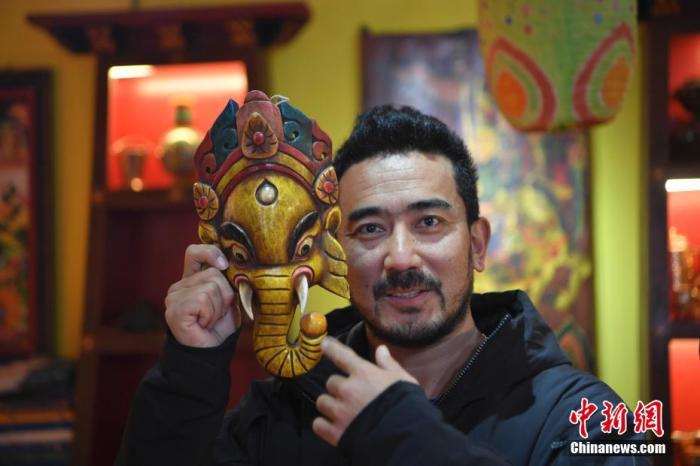China News Service, Shangri-La, November 22 (Miao Chao) In Shangri-La, a famous tourist destination in Yunnan, almost half of the Tibetan men are called "Tashi".
When shouting "Tashi" on the street, many men will look back.
Among them, there is a Nepalese with thick eyebrows, big eyes and a typical tough guy-Tashi Ramasan.
A Nepalese with thick eyebrows and big eyes, with the image of a typical tough guy-Tashi Ramasan.
Photo by China News Agency reporter Liu Ranyang
Recently, a reporter from China News Service visited Shangri-La City, Diqing Tibetan Autonomous Prefecture, Yunnan Province, to visit Tashi Lamasang’s “gold rush” life in Shangri-La.
He told reporters, "During my 17 years of living in Shangri-La, I have shared the dividends of the economic development of Nepal and China."
Tashi Ramathan is 41 years old and was born in Kathmandu, Nepal in 1979.
Half of his ancestry is Tibetan, and half of his ancestry is Rama.
Since 2003, he has lived in Shangri-La for 17 years and currently operates two inns and two Nepalese merchandise stores in the ancient city of Dukezong.
Tashi Ramasan is 41 years old and currently runs two inns and two Nepalese merchandise stores in the ancient city of Dukezong.
Photo by China News Agency reporter Liu Ranyang
At the age of 19, Tashi Ramasan borrowed money from his mother to run a video shop in Kathmandu, renting out Bollywood movies from India and DVDs from Hollywood movies.
The small shop not only prospered, but also let him reap love.
A Tibetan girl named Suolang lives upstairs in the video product store. She often goes to the store to rent movie discs.
"Her family used to be members of the caravan and travelled on the ancient tea-horse road between Lhasa, China and Kathmandu, Nepal. Later, the family settled in Kathmandu." After a long period of time, Tashi Ramasang and Suolang had a relationship.
After the marriage, Tashi Lamasan was taken by Suolang and came to China for the first time.
They traveled to Lhasa, Nyingchi and other places, and arrived in Shangri-La in the summer of 2003.
"At that time, the Shangri-La meadows were full of colorful unknown flowers, yaks were grazing quietly at the foot of the snow-capped mountains, and low storage houses were scattered at the foot of the majestic Songzanlin Temple..."
The "beauty" of Shangri-La made Tashi unable to extricate himself.
He decided to stay and stay in this paradise on earth.
At that time, the Shangri-La tourism industry had gradually emerged, and tourists from all over the world flocked in.
However, there are very few local English speakers, and Tashi sees an opportunity.
"I can speak English and Tibetan, and I am learning Chinese, so I cooperated with a travel agency to develop trekking routes in Shangri-La." Tashi said, "Nepal trekking is world-renowned, especially the Himalayas trekking guided by Sherpas. There are many models and experiences."
The picture shows on November 21, Tashi buys dinner ingredients at the vegetable market, preparing to make curry chicken for friends to eat.
Photo by China News Agency reporter Liu Ranyang
Under the guidance of Tashi, the travel agency has developed tourism products in Shangri-La that combine beauty and culture, such as trekking Meili Snow Mountain and trekking the Ancient Tea Horse Road, which are quite popular among Chinese and foreign tourists.
At that time, tourists who had experienced the charm of Shangri-La always asked him: What special products does Shangri-La have?
Tashi Lamasan enthusiastically recommends traditional handicrafts such as Nixi clay pottery and Tibetan wooden bowls, "but tourists always want more varieties of handicrafts."
Nepalese handicrafts are famous all over the world for their exquisiteness.
Therefore, in 2010, Tashi rented a 30-square-meter shop in Dukezong, the ancient city of Shangri-La, and named it "Himalayan".
Started selling specialty crafts including Nepal.
"Both Nepal and Shangri-La are located in the great Himalayas. The cultures of the two places are similar. In a sense, Nepalese handicrafts are also one of Shangri-La's specialties." As expected, he brought handmade soaps and woodwork from Nepal. Products, copper art products, thangka...combined with Shangri-La and handicrafts from all over China, the "Himalayan" is instantly dazzling.
The "Himalayan" "cooperation" of Chinese and Nepalese handicrafts is very popular among tourists, and Tashi Ramasang noted the new demands of tourists. "At that time, Shangri-La's accommodation conditions were poor and tourists complained more."
He then rented land in the ancient city of Dukezong and built a boutique inn "Bodhi Heart Courtyard."
Tourists walked into the inn, listened to Nepalese music, admired the exquisite thangka and the southern foot of the Himalayas oil paintings, tasted various curries and scones.
On November 21, Tashi invited his friends to a Nepalese meal.
Photo by China News Agency reporter Liu Ranyang
In recent years, the economic and trade cooperation between China and Nepal has been continuously deepened, and China has become Nepal's second largest trading partner.
Tashi Ramathan claimed to be a sharer of the economic development dividends between Nepal and China.
Not long ago, he opened a handicraft shop in Shangri-La, while preparing to open another inn.
"At present, Nepalese handicrafts and curry seasonings are available on the Chinese e-commerce platform." He said bluntly that he is now more and more worried about the future "money" of his handicraft store.
However, he is very pleased that his wife Suo Lang runs a jewelry shop in Lhasa, Tibet.
"The business in her shop has always been good! Those rings, necklaces, corals, and beeswax that are made in Nepal and China and are full of exotic flavors and characteristics are particularly popular." Tashi Ramasan said, "China is now rich Tibetans, Hans, Huis...are particularly willing to dress up." (End)

